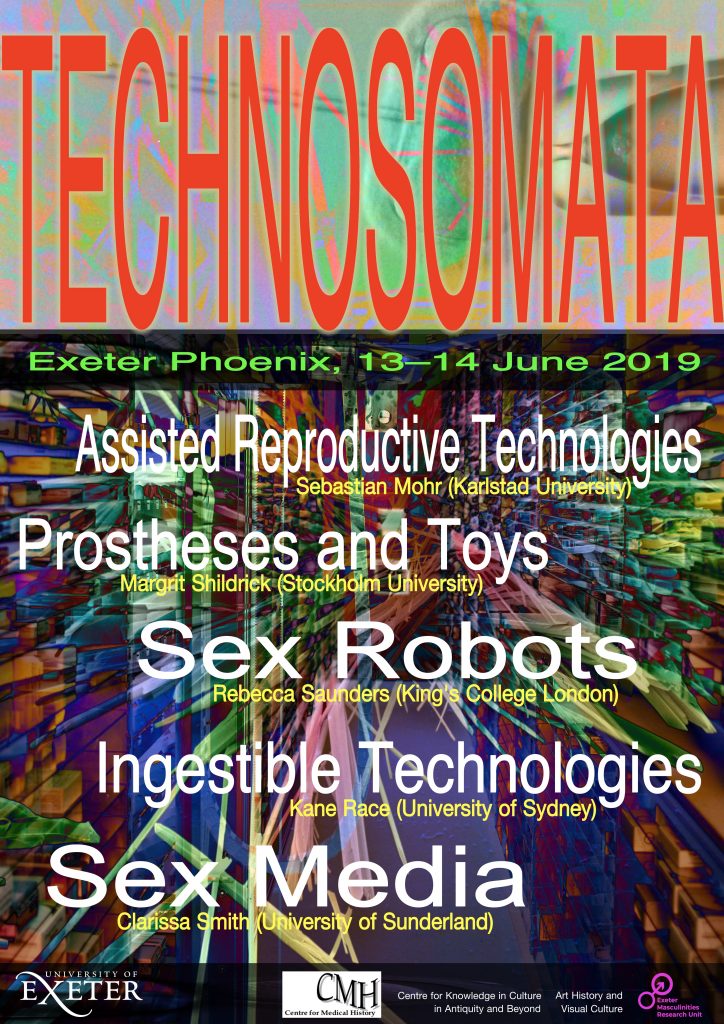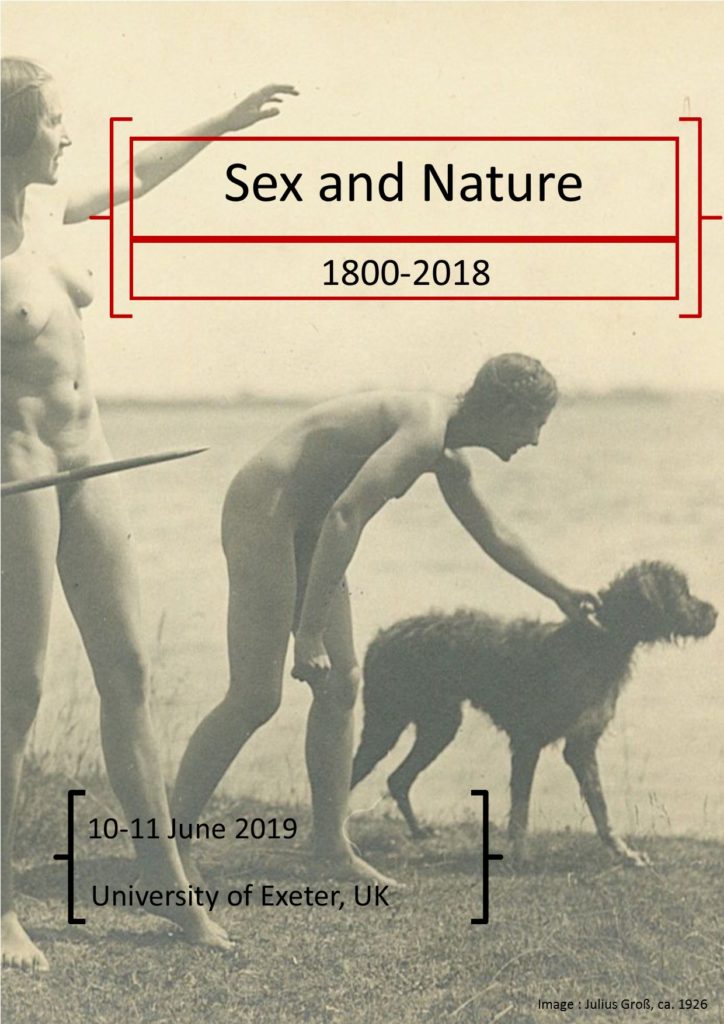
Tag Archives: Internal Event
Technosomata Workshop 1
TECHNOLOGY, SEX AND GENDER IN CLASSICAL ANTIQUITY
7th of June 2019
Amory Building Room 315
Convened by: Maria Gerolemou
Supported by the Centre for Knowledge in Culture in Antiquityand Beyond and the Centre for Medical History, University of Exeter
This workshop proposes to explore the ways that technology (defined as techniques) produces, configures or reshapes gender and sexuality. Cosmetics, prosthetics, athletics, pharmaceutics and sexual tools can all be considered in terms of enhancement technologies with a variety of aims, including longevity, and at healthier and improved appearance. In this respect, they have a pervasive impact on gender, as they redefine the limits of the physical body, as well as on sexuality in terms of rewriting the script for erotic action emphasizing sexual pleasure, or assisting/preventing reproduction.
PROGRAMME
8.45-9.00 Registration
9.00-9.15: Kate Fisher, Rebecca Langlands, Maria Gerolemou, Introductory speech
9.15-10.00, Jane Draycott (Glasgow), Gendering Therapeutic Body Modification and Bodily Enhancement Technologies
10.00-10.45, Maria Gerolemou (Exeter), Want to look younger and beautiful?Steamy baths in classical antiquity
10.45-11.15 Coffee/Tea Break
11.15-12.00, Alessia Gurdasole (CNRS Paris), Dysfunction (δυσέργεια) and deformity (ἀπρέπεια) in Paul of Aegina’s surgical chapters
12.00-12.45, Daniel King (Exeter), Galen’s athletics
12.45-1.30, Genevieve Liveley (Bristol), Natural born cyborgs: Or, when Talos met Medea
1.30-2.30, Lunch
2.30-3.15, Laurence Totelin (Cardiff), Lizards and Lettuces: aphrodisiacs as technosõmata
3.15-4.00, Francesca Spiegel (HU Berlin), The Abortion of Oedipus: On contraception
4.00-4.45, Karen Ni-Mheallaigh(Exeter), Prosthetic penises and removable eyes: bionic life on the Moon
4.45-5.15 Coffee/Tea Break
5.15-6.00, Giulia Maria Chesi (HU Berlin), Ethiopian cosmetics vs. Persian commotics in Herodotus’ Ethiopian logos
6.00-6.45, Martin Devecka (UC Santa Cruz), The Human Touch: Prosthetic Gendering of Animal Bodies in the Roman Empire
7.30 Dinner
Conference: Sex and Nature, 1800–2018
Keynote speakers:
Greta LaFleur, Yale University, USA
Astrida Neimanis, University of Sydney, Australia
Artist in Residence:
Amy Cutler, Royal Holloway, University of London, UK
Since 2016 the Ecosexual Bathhouse art venue has been touring the world. Designed by the Pony Express artist collective, this roving multi-chamber venue aims to explore ecological fantasies: visitors can visit a pollination gallery, a composting glory hole, and a honey bee swarm. Activating desire and channelling erotic expression towards the elements of water, earth, air and fire, the project aims to nurture a visceral connection to nonhuman animals, plants, minerals, and inanimate materials.
The Ecosexual Bathhouse is but one of a number of exemplary case studies that disrupt and display the entangled categories of “sex” and “nature.” This conference aims to interrogate and investigate diverse moments and sites where sex and nature, along with their practices, aesthetics, methodologies, and conceptual histories, are becoming visible in new and unexpected contexts, both in the present and the past, from sexologist Magnus Hirschfeld’s interest in ‘intersex butterflies’ in the 1920s to the botanical sex scene of Han Kang’s The Vegetarian (2007).
Historically, the relationship between sex and nature has long been contested. Ideas of nature and the natural have often been employed to secure and essentialise heteronormative binaries of sex, gender and sexuality. Much feminist and queer scholarship has been dedicated to revealing and challenging such uses of the natural. At the same time, the relationship between nature, the natural and sex has been interpreted to support a variety of causes: in the late nineteenth century, for example, feminists took on the cause of anti-vivisection because they saw it as indicative of a common objectification of women and animals. From Darwin and Linnaeus to Krafft-Ebing and Kinsey, categories of sex and sexuality were introduced into concepts of nature and the natural world. This categorisation of sex and nature led to highly contested and politicised debates among their contemporaries. More recently, the relationship between sex and nature has opened up debates in ecofeminism (Greta Gaard, Val Plumwood), material feminism (Elizabeth Wilson, Stacey Alaimo) and Anthropocene feminism (Claire Colebrook) that seek to rethink the relationship between sex and nature. Instead of rejecting or challenging the idea of the natural, such scholarship has demonstrated the queer and feminist potential of nature. Ground-breaking treatments of nature and sex have led to robust theorizations of queer ecologies (Catriona Sandilands, Astrida Neimanis), natural histories of sexuality (Greta LaFleur) and new kinship forms through reproductive technologies (Sarah Franklin), to name but a few.
The conference welcomes scholars from all disciplines drawing on a broad range of methodologies and focusing broadly on the period since 1800. We aim to explore the entangled categories of sex and nature by examining a wide range of topics related, but not restricted to:
- Natural histories of sex and sexuality
- Sexuality and nature: naturalising sexuality, sexing nature
- Queering nature, naturalising queerness
- (Un)natural sex, (de)naturalising sex, (re)naturalising sex
- The politics of sexual nature
- Nature, naturalness and normativity
- Nature and feminist critique, past and present
- The sexual politics of biotechnological reproduction
- (De)extinction and (re)production
- Sex and nature in the Anthropocene
- Authorities on nature beyond natural sciences
- Race, indigeneity, sex and nature
- Human, animal, vegetable sexuality
- Sex, nature and disability
- Intra-species sexualities from prehistory to the present
- Intersex across species-boundaries
This conference is generously supported by the Wellcome Trust-funded Rethinking Sexology project.

Viral Masculinities (Free online conference)
Keynote Speakers:
Professor John Mercer (Birmingham City University)
Professor Susanna Paasonen (University of Turku)
Professor Tim Dean (University of Illinois)
We’re living in viral times; ours is a time of contagion. As Tony Sampson writes in his book Virality: Contagion Theory in the Age of Networks, “the networked infrastructures of late capitalism are interwoven with the universal logic of the epidemic” (Sampson 2011, 1–2). Deeply connected to contemporary biopolitics and modes of digital sociability, virality also underpins news forms of wealth creation and accumulation sustained by 21st-century media, whilst at the same time (paradoxically, perhaps) presenting a political threat through the risk it carries of “contagious overspills” that may undo borders, nation states, institutions, ontologies and subjectivities (2). Defined by Sampson as “contagious relationality” (3), in the age of memes, “fake news,” hacking, epidemics, ecological crisis, global migration flows, antiretroviral drugs, YouTube and Pornhub, virality is at the centre of contemporary forms of both control and liberation (5–6). Whilst, on the one hand, it sustains the logics of 21st-century biopolitics (antiretrovirals, hygiene, cyber security, ID and age-verification systems, etc.), on the other, it has the capacity to disrupt subjectivities and social assemblages, a capacity that resides in its ability to facilitate unforeseen flows of desire and affect (chemsex parties organised through Grindr and facilitated by Uber, biohacking, citizen journalism, Wikileaks, Anonymous, the “Arab Spring,” the “Yellow Vest Movement,” etc.).
If our time is a game of push and pull fuelled on all sides by contagious forms of relationality, what then for masculinities? If our understandings of masculinity are “inherently relational” (Connell 2005, 68), what happens to them in a context of “contagious relationality” (Sampson 2011, 3)? If “gender is a way in which social practice is ordered” (Connell 2005, 71), what has been the impact on masculinities of a social order both coded and disrupted through viral means?

